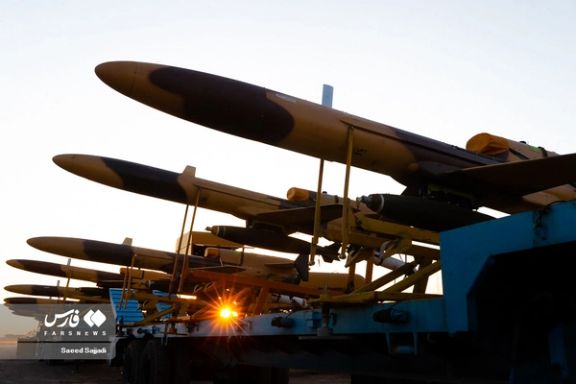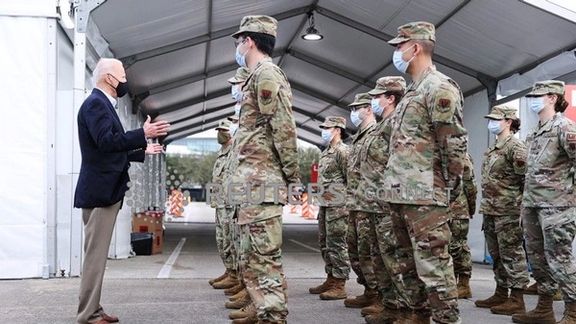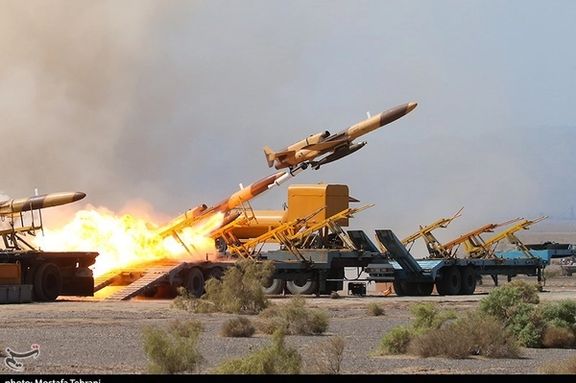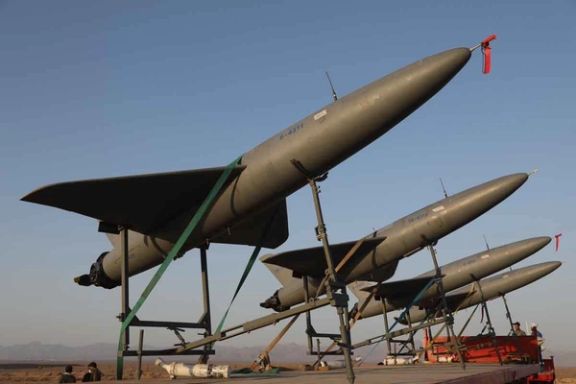Russia Obtained Hundreds Of Drones From Iran - Report

Western intelligence officials say Russia has obtained hundreds of Iranian drones capable of being used in its war against Ukraine despite US warnings to Tehran against the move.

Western intelligence officials say Russia has obtained hundreds of Iranian drones capable of being used in its war against Ukraine despite US warnings to Tehran against the move.
It is not officially announced whether Russia has begun flying the drones against Ukrainian targets, but the drones appear to be operational and ready to use, said the officials, who spoke to the Associated Press on condition of anonymity to discuss sensitive intelligence.
The reported shipment marks the latest sign of what appears to be closer military cooperation between the longtime allies, which are also broadening their relations in other sectors such as space programs, aviation and automotive industry.
It also underscores warnings from critics of the ongoing negotiations with Iran to revive the 2015 nuclear deal that the United States left in 2018. An agreement, which would grant Iran billions of dollars in sanctions relief in return for curbs on its nuclear program, is inching forward.
In mid-August, Iran’s Revolutionary Guard confirmed that it held joint drone exercises with Russia at the Kashan Air Base, adding that Belarus and Armenia were also partaking in the drills.
Earlier in the month, US-based think tank, the Institute for the Study of War quoted advisor to the Ukrainian President’s Office, Oleksiy Arestovych, as saying that Iran handed 46 drones over to Russia and that the Ukrainian government has already noted the use of these drones in combat in Ukraine.
Late In July, an Iranian lawmaker said military cooperation between Tehran and Moscow has upset the political equations of the global order, confirming Russia’s request to buy Iranian drones.

US President Joe Biden ordered a series of strikes on Iranian militia in Syria “to degrade and disrupt” attacks on US forces, he told Congress on Thursday.
The first strike took place on August 23 against a facility “used by militia groups affiliated with Iran’s Islamic Revolutionary Guard Corps that have been involved in a series of unmanned aerial vehicle, rocket, and mortar attacks against United States personnel and facilities in Syria,“ Biden said in his letter.
The militia under Iranian command launched a new attack on Wednewsday and the United States had to again react, launching new strikes. The scenario repeated itself on Thursday, killing four militiamen.
Biden wrote to the leaders of the House of Representative and the US Senate "consistent with the War Powers Act“. But it he directly said this was a message to Tehran.
"I directed the August 23 strikes," Biden wrote, "to deter the Islamic Republic of Iran and Iran-backed militia groups from conducting or supporting further attacks on United States personnel and facilities."
Iranian government media and officials remained silent on Thursday, ignoring the events publicly. But on Friday, Iran’s foreign ministry spokesman Nasser Kanaani rejected President Biden’s argument that the US is responding to threats against American forces. Kanaani tweeted, “Fact: The very presence of occupier America in Syria and its transgressions against the defenders of Syria’s independence and territorial integrity is illegal and condemned.”
Knaani on Wednesday had denied any links between Iran and the militia forces in Syria, a claim few would také seriously, given Iran’s 11-year involvement in the Syrian civil war and hundreds of casualties among its forces and those of its militia.
At the same time, Biden used wording in his letter to emphasize the "discrete" and "proportionate" nature of the military action, amid highly sensitive indirect negotiations with Tehran to restoire the 2015 nuclear agreement, the JCPOA.
Iran has received the latest US response to a European Union draft proposal on bridging the remaining gaps and it announced Thursday that its experts and deecision makers are carefully examining the text.
Biden, however, faces strong domestic opposition for trying to restore the JCPOA and lift economic sanctions imposed on Iran. The attaks in Syria can help paint a picture of the President as a man ready to stand up to Tehran.
The initial incident that let to the first US strike against Iran-affiliated forces on Tuesday was an attack on US forces on August 15, the same day that Iran had responded to the EU proposal. While Iran appears serious about continuing nuclear talks, it is not clear why forces under its command in Syria would provoke the United States.
Iran’s Supreme Leader Ali Khamenei and his hardliner supporters have long called for all American forces to leave the Middle East, meaning primarily Iraq and Syria. At he same time, Washington and its allies in the region have long accused Iran of "malign activities" by organizing and supporting militant Shiite groups to carve out zones of Iranian influence all the way to the Mediterranean.
Iran’s Revolutionary Guard and its affiliated entities have been sanctioned by the United States partly for this reason, and their sanctioned status became part of the nuclear negotiations this year. The US rejected Iranian demands to remove the sanctions and Tehran appears to have backed off.

The US military on Thursday hit several targets in the Syrian city of Mayadin in parts of Deir ez-Zor province in the third day of skirmishes with Iran-backed groups.
According to local military sources, at least three members of an Iran-aligned militia were killed when they were targeted by a US helicopter as they were about to prepare a rocket launcher in the town.
Iranian militias have a strong presence in the town and have repeatedly targeted the nearby Al Omar oilfield on the eastern bank of the Euphrates where the US coalition has its biggest base in Syria.
The base also known as Green Village was targeted on Wednesday night in a second consecutive day of violence between the US military and Iran-backed militants that injured at least one US service member and killed up to four militants.
According to CENTCOM, Iran-affiliated militants in the area were struck by AH-64 Apache attack helicopters, AC-130 gunships, and M777 artillery. “We will respond appropriately and proportionally to attacks on our servicemembers. No group will strike at our troops with impunity. We will take all necessary measures to defend our people,” said Michael “Erik” Kurilla, the commander of US Central Command.
Military tensions escalated between US forces and Iranian militia in Syria as nuclear talks between Tehran and Washington seemed to be making some progress.
Earlier in the week, Iran’s state-run media said a senior member of Iran’s Revolutionary Guard’s Ground Force was killed in Syria in the early hours of August 22, claiming that the general was killed as he was serving as a "military advisor" in the country.
Later on Thursday, Syrian media reported loud explosions near Masyaf and Tartous, in Western Syria. According to the Syrian observatory for human rights, it was an Israeli air strike.

A probe supported by a British advocacy group into attacks by Syrian government forces that left 700 people dead in Darayya, Syria 10 years ago has revealed Iranian and Hezbollah militias’ involvement.
A team of investigators from Syria, or of Syrian descent, backed by the Syrian British Consortium (SBC) advocacy group, tracked down survivors and witnesses from around the world to analyze their testimonies, and published their findings on Thursday, hoping that UN bodies and other legal institutions use the report to prosecute some of those responsible.
The report said investigators were able to identify government forces and Iranian and Hezbollah militias involved in the attacks by their uniforms, insignia and weaponry, including types of tanks, as well as how members of the units addressed each other.
The team also identified some individuals responsible. “This investigation reveals that the Assad Government and supporting Hezbollah and Iranian militias engaged in a systematic attack against the civilian population of Darayya from August 20 to 26, 2012”, as they advanced against the town from multiple directions and indiscriminately attacked neighborhoods by shelling and airstrikes, and deliberately targeted hospitals.
Reports regarding the involvement of Iranian troops grew after August 5, 2012 (two weeks before the Darayya massacre), when a Free Syrian Army brigade captured 48 active-duty members of the Iranian Revolutionary Guard in the southeastern part of Damascus, a few kilometers away from Darayya.
One witness told researchers that the scene at the hospital after one attack was “horrific, like doomsday”. “Everyone was looking for their loved ones, trying to get them treatment. People were running and hiding.”

Iranian media say two servicemen from the Revolutionary Guard were killed in the southern city of Shiraz but there are unconfirmed reports that the two died in Syria.
Telegram channels affiliated with the IRGC said on Thursday that Mohammad Eslami and Mohammad Sajjadizadeh were killed in the Fars province on Wednesday, adding that they were “martyred” during skirmishes with the outlaws. Iranian media did not provide any further details about their deaths.
However, there are social media reports that the two were killed when US hits Iran-backed forces in Syria after a second rocket attack on Tuesday and Wednesday on facilities used by groups under IRGC control in Syria’s Deir ez-Zor.
Iran International cannot independently confirm any of the conflicting claims.
US attack helicopters destroyed three vehicles of Iranian militia In Syria Wednesday evening local time that had fired rockets at American forces. Three militiamen were reportedly killed in the US retaliatory attack. The United States also conducted an air strike Tuesday at suspected militia who had conducted a rocket attack on August 15 against US forces.
There are reports that the US military carried out a third round of airstrikes in Al-Mayadin, in the same area, against “Iran-backed” groups on Thursday. The fresh raids have reportedly left casualties.
Military tensions escalated between US forces and Iranian militia in Syria as nuclear talks between Tehran and Washington seemed to be making some progress.
Earlier in the week, Iran’s state-run media said a senior member of Iran’s Revolutionary Guard’s Ground Force was killed in Syria in the early hours of August 22, claiming that the general was killed as he was serving as a "military advisor" in the country.

The Iranian army has unveiled an underground military base on the second day of its countrywide drone war games, featuring its latest unmanned aerial vehicles.
Vice Admiral Mahmoud Mousavi, the spokesman for the drone exercises, said Thursday that during the second day of the drills a set of mock targets modeled from “sensitive and vital” facilities were destroyed by actual weapons.

He added that Kaman, Mohajer, Ababil, Karrar, and Bavar drones used homegrown weapons, including Qa’em bombs, Almas missiles and MK-82 bombs, to target positions ranging from command-and-control centers to fuel tanks, ammunition depots, and radar and missile systems.

Mousavi said various types of combat drones operated by the four units of the Army, namely the Ground Force, Navy, Air Force and Air Defense Force, hit the designated targets in the area of the exercises — which covers almost all the Iranian territory and strategic southern waters.
Iran’s Army started a large-scale drone drill on Wednesday, featuring its reconnaissance and combat drones in the Persian Gulf and the Sea of Oman, as well as all over its territory.
Deputy Chief of the Iranian Army for Coordination Rear Admiral Habibollah Sayyari said on Tuesday that more than 150 new advanced drones will be flown in the drill.
Earlier in the month, Iran’s Revolutionary Guard confirmed that it held joint drone exercises with Russia at the Kashan Air Base, adding that Belarus and Armenia are also partaking in the drills.